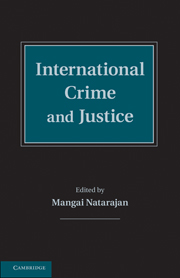Book contents
- Frontmatter
- Contents
- List of Figures
- List of Tables
- List of Contributors
- Foreword
- Preface
- Introduction
- Part I International Criminology
- Part II Law, Punishment, and Crime Control Philosophies of the World
- Part III Transnational Crime
- 14 Drug Trafficking
- 15 Understanding Trafficking in Human Beings
- 16 International Trafficking of Stolen Vehicles
- 17 Transnational Firearms Trafficking
- 18 Trafficking Antiquities
- 19 The Illegal Cigarette Trade
- 20 Cybercrime
- 21 International Fraud
- 22 Money Laundering
- 23 Child Pornography
- 24 Maritime Crime
- 25 Transnational Environmental Crime
- 26 The Bhopal Gas Disaster and Corporate Criminal Negligence
- 27 Endangered Species Markets
- 28 Corruption
- 29 Tourist and Visitor Crime
- Part IV Organized Crime and Terrorism
- Part V International crime
- Part VI Delivering International Justice
- Part VII International Cooperation and Criminal Justice
- Part VIII International Research and Crime Statistics
- Part IX International research resources
- World Map
- Index
- References
15 - Understanding Trafficking in Human Beings
A Human Rights, Public Health, and Criminal Justice Issue
Published online by Cambridge University Press: 05 October 2014
- Frontmatter
- Contents
- List of Figures
- List of Tables
- List of Contributors
- Foreword
- Preface
- Introduction
- Part I International Criminology
- Part II Law, Punishment, and Crime Control Philosophies of the World
- Part III Transnational Crime
- 14 Drug Trafficking
- 15 Understanding Trafficking in Human Beings
- 16 International Trafficking of Stolen Vehicles
- 17 Transnational Firearms Trafficking
- 18 Trafficking Antiquities
- 19 The Illegal Cigarette Trade
- 20 Cybercrime
- 21 International Fraud
- 22 Money Laundering
- 23 Child Pornography
- 24 Maritime Crime
- 25 Transnational Environmental Crime
- 26 The Bhopal Gas Disaster and Corporate Criminal Negligence
- 27 Endangered Species Markets
- 28 Corruption
- 29 Tourist and Visitor Crime
- Part IV Organized Crime and Terrorism
- Part V International crime
- Part VI Delivering International Justice
- Part VII International Cooperation and Criminal Justice
- Part VIII International Research and Crime Statistics
- Part IX International research resources
- World Map
- Index
- References
Summary
INTRODUCTION
The United States Department of State (2009) has documented trafficking in human beings and their exploitation in 175 countries around the world. Trafficking affects the most vulnerable in the poorest societies, often women and children. With promises of good jobs and salaries, educational opportunities or marriage, unsuspecting victims are lured into virtual slavery often coupled with psychological, physical, and sexual abuse. The International Labour Organization (2005) estimates that 2.45 million people worldwide are in forced labor as a result of trafficking. According to the United Nations, the trafficking industry is estimated to be worth between five to seven billion U.S. dollars annually.
While much attention has been focused on the trafficking of women and children for sexual exploitation, trafficking can occur in any industry in which there is a demand for cheap labor. Trafficking and exploitation have been documented in the construction, brick making, domestic, food service industries, on farms, and on fishing boats. Trafficking also occurs for the purpose of prostitution, sex tourism, child soldiering, forced begging, and organ harvesting. The markets and industries differ across regions and countries and within countries and cities (Aronowitz, 2009).
- Type
- Chapter
- Information
- International Crime and Justice , pp. 118 - 125Publisher: Cambridge University PressPrint publication year: 2010
References
- 5
- Cited by

